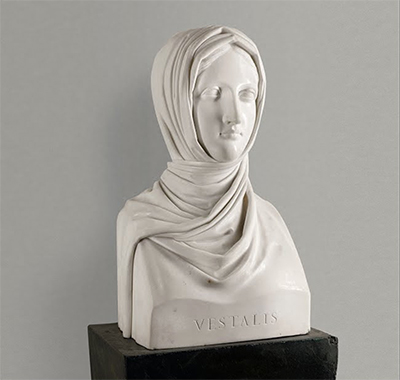Vestal Virgin served in the temples of the Roman goddess, Vesta. Their role was to act as guardians of an eternal and sacred flame. At the same time, there was a requirement for them to be pure and chaste like the goddess.
In 1819, the Italian sculptor, Antonio Canova used the idea as inspiration to sculpture the marble bust of the Vestal Virgin. Titled Vestalis, it is on display at the Gallery of Modern Art in Milan. Canova's sculpture of the Vestal Virgin depicts the ideal of female beauty. He does this by using simple geometric shapes to give form to the head. The sculpture’s face is an oval shape while the bust is a square shape. While the Vestal Virgin has physical beauty, her stare is unmoving. The female’s expression shows both resolve and innocence, as well as a moral authority. The covering around the female’s head pulls in her hair, leaving only her face visible.
Based on the discovery of the House of the Vestals in Pompeii, it’s likely that Canova researched the subject before he began his work. This accounts for why there is a belief that the head covering is historically accurate. The word Vestalis is visible on the front of the sculpture. Canova sculptured the bust in marble. It measures approximately 53 x 31 x 23 cm. It is one of three similar sculptures that he created. As well as Vestal Virgin another has the title, Herm of a vestal virgin. Although similar, it's possible to tell them apart. The main difference is that the Vestal Virgin bust has a square edge at the front while the Herm of a vestal virgin slopes down. Canova started work on the sculpture of the Vestal Virgin in 1818.
He completed the bust in 1819 and sold it to Luigi Uboldi, a Milanese banker. When Uboldi died, he left the sculpture to the Brera Academy in his will. The academy sold the bust to the Gallery of Modern Art in Milan in 1902. Canova's style allows him to capture in the bust, the Vestal Virgin's beauty and innocence. He does this by using the austerity and sparseness that is the Neoclassical style. As a Neoclassical sculptor, Canova's artistic motivation was that classical forms come with the expression of strict morality. His style came from being inspired by the works of ancient times.




